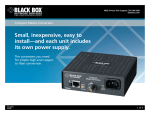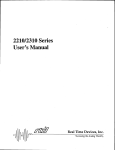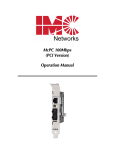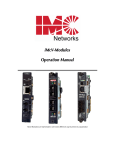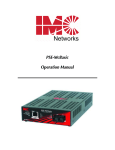Download Black Box LMC009A-R5 Instruction manual
Transcript
Compact Media Converter FEDERAL COMMUNICATIONS COMMISSION RADIO FREQUENCY INTERFERENCE STATEMENT This equipment has been tested and found to comply with the limits for a Class A computing device, pursuant to Part 15 of the FCC Rules. These limits are designed to provide reasonable protection against harmful interference when the equipment is operated in a commercial environment. This equipment generates, uses and can radiate radio frequency energy and, if not installed and used in accordance with the instruction manual, may cause harmful interference to radio communications. Operation of this equipment in a residential area is likely to cause harmful interference in which the user will be required to correct the interference at his own expense. Any changes or modifications not expressly approved by the manufacturer could void the user's authority to operate the equipment. The use of non-shielded I/O cables may not guarantee compliance with FCC RFI limits. This digital apparatus does not exceed the Class A limits for radio noise emission from digital apparatus set out in the Radio Interference Regulation of the Canadian Department of Communications. Le présent appareil numérique n’émet pas de bruits radioélectriques dépassant les limites applicables aux appareils numériques de classe A prescrites dans le Règlement sur le brouillage radioélectrique publié par le ministère des Communications du Canada. Installation Guide LMC001A-R5 - LMC002A-R5 - LMC003A-R5 LMC004A-R5 - LMC007A-R5 - LMC008A-R5 LMC009A-R3 About Compact Media Converters The Compact Media Converter series is IEEE 802.3 compliant, providing a singleconversion between 10 Mbps twisted pair and either 10 Mbps fiber or thin coax. Each Compact Media Converter is a 1U high, standalone unit that includes diagnostic LEDs for each port and an internal universal (100-240 VAC) power supply. Q U I C K S T A R T Introduction Installation Configuration Crossover/Pass-Through LinkLoss & Pulsing FiberAlert LED Operation Technical Support Warranty Safety Certifications 1 1 2 2 2 4 6 7 8 The following Compact Media Converter versions are available: SAFETY CERTIFICATIONS UL/CUL: Listed to Safety of Information Technology Equipment, Including Electrical Business Equipment. CE: The products described herein comply with the Council Directive on Electromagnetic Compatibility (89/336/EEC) and the Council Directive on Electrical Equipment Designed for use within Certain Voltage Limits (73/23/EEC). Certified to Safety of Information Technology Equipment, Including Electrical Business Equipment. For further details, contact Black Box. Class 1 Laser product, Luokan 1 Laserlaite, Laser Klasse 1, Appareil A’Laser de Classe 1 10BT (RJ-45) - 10BFL — 10Base-T twisted pair/10Base-FL 850 nm multimode fiber; includes one RJ-45 connector and one pair ST (LMC001A-R5) or SC (LMC002A-R5) connectors. 10BT (RJ-45) - 10BFL/1300 — 10Base-T twisted pair/10Base-FL 1300 nm multi-mode fiber; includes one RJ-45 connector and one pair ST (LMC003A-R5) or SC (LMC004A-R5) connectors. 10BT (RJ-45) - 10BFL SM/PLUS — 10Base-T twisted pair/10Base-FL 1310 nm single-mode fiber; includes one RJ-45 connector and one pair ST (LMC007A-R5) or SC (LMC008A-R5) connectors. 10BT (RJ-45) - 10B2 (BNC) — 10Base-T twisted pair/10Base-2 thin coaxial; includes one RJ-45 connector and one BNC connector (LMC009A-R3) Installing Compact Media Converter 1000 Park Drive • Lawrence, PA 15055-1018 USA TEL: (724) 746-5500 • FAX: (724) 746-0746 E-MAIL: [email protected] WEB: http://www.blackbox.com © 2001-2005 Black Box Corporation. All rights reserved. The information in this document is subject to change without notice. Black Box Corporation assumes no responsibility for any errors that may appear in this document. Specific brands and product names may be trademarks and are the property of their respective companies. Document Number 55-80226BB-01 A0 February 2005 8 Each Compact Media Converters come ready to install; configure after installation. To install a Compact Media Converter, first make sure that the unit is placed on a suitable flat surface. Attach the cables between the Compact Media Converter and each device that will be interconnected, then plug the unit into a reliable, filtered power source. IMPORTANT INSTALLATION INFORMATION! Compact Media Converters do not auto-negotiate, therefore Black Box does NOT recommend connecting them to a switch, media converter or other device that ONLY auto-negotiates; connect to devices that are 10 Mbps or to devices that you can force to 10 Mbps. 1 Configuring Compact Media Converter Once installed, configure Compact Media Converter TP/FO for the following: • A crossover or pass-through connection for the twisted pair port • Pulsing FiberAlert Once installed, configure Compact Media Converter TP/BNC for the following: • A crossover or pass-through connection for the twisted pair port • BNC port termination (default = Enabled) Twisted Pair Crossover/Pass-Through Switch FIBER OPTIC CLEANING GUIDELINES Fiber Optic transmitters and receivers are extremely susceptible to contamination by particles of dirt or dust, which can obstruct the optic path and cause performance degradation. Good system performance requires clean optics and connector ferrules. 1) Use fiber patch cords (or connectors, if you terminate your own fiber) only from a reputable supplier; low-quality components can cause many hard-to-diagnose problems in an installation. 2) Black Box installs dust caps to ensure factory-clean optical devices. Do not be remove these protective caps until the moment of connecting the fiber cable to the device. Assure that the fiber is properly terminated, polished and free of any dust or dirt, and that the location is as free from dust and dirt as possible. The twisted pair port on 10 Mbps Compact Media Converters features a pushbutton switch, located next to the twisted pair connector, for selecting a crossover workstation connection or pass-through repeater/hub connection. 3) Store spare caps in a dust-free environment such as a sealed plastic bag or box so that when reinstalled they do not introduce any contamination to the optics. Select a pass-through connection by pressing the push-button IN. A crossover connection is selected when the push-button is OUT. If uncertain whether a crossover or pass-through connection is needed, set the push-button to the position that makes the TP LNK (link) LED glow. 5) If you suspect that the optics have been contaminated, alternate between blasting with clean, dry, compressed air and flushing with isopropyl alcohol to remove particles of dirt. 4) Should it be necessary to disconnect the fiber device, reinstall the protective dust caps. ELECTROSTATIC DISCHARGE PRECAUTIONS Electrostatic discharge (ESD) can cause damage to your add-in modules. Always observe the following precautions when installing or handling an add-in module or any board assembly. BNC Port Termination Compact Media Converter TP/BNC features a 2-position switch next to the BNC connector that allows a thin coaxial segment to be terminated at the port without an additional ‘T’ connector and terminator. If Compact Media Converter TP/BNC is attached to a mid-point of a thin Ethernet segment, attach a ‘T’ connector to the BNC port. Termination must be OFF (disabled). Termination is disabled when the switch is in the left position. If a thin Ethernet segment is to be terminated at the Compact Media Converter TP/BNC, attach the cable directly to the BNC connector and set the termination switch to ON (enabled – factory default) by moving the switch to the right position. LinkLoss and Pulsing FiberAlert 1) Do not remove unit from its protective packaging until you’re ready to install it. 2) Wear an ESD wrist grounding strap before handling any module or component. If you do not have a wrist strap, maintain grounded contact with the system unit throughout any procedure requiring ESD protection. WARNING! Integrated circuits and fiber optic components are extremely susceptible to electrostatic discharge damage. Do not handle these components directly unless you are a qualified service technician and use tools and techniques that conform to accepted industry practices. 3) Hold boards by the edges only; do not touch the electronic components or gold connectors. 4) After removal, always place the boards on a grounded, static-free surface, ESD pad or in a proper ESD bag. Do not slide the board over any surface. WARRANTY Contact Black Box for warranty information. LinkLoss and Pulsing FiberAlert are advanced troubleshooting features from Black Box that can help you locate “silent failures” on your network. It is vital that you understand exactly how Pulsing FiberAlert and LinkLoss work and how they will react in your network configuration before attempting to install the enclosed unit. 2 7 Installation Troubleshooting • During installation, first test your fiber and twisted pair connections with all troubleshooting features disabled. Then enable these features, if desired, just before final installation. This will reduce the features’ interference with testing. • To test Compact Media Converter TP/FO by itself, you must have an appropriate fiber patch cable. First, connect Compact Media Converter TP/FO to the twisted pair device with a twisted pair cable and establish valid link. Next, loop a single strand of fiber from the transmit port to the receive port of your media converter. Finally, verify that you have both twisted pair and fiber link on your media converter. • Make sure that you are using the appropriate twisted pair cable or have the crossover/pass-through button on the media converter set correctly. • Interconnection between the Next Generation of 10 Mbps converters (Compact Media Converter, SNMP Manageable module or unmanaged module) and their Legacy counterparts is possible. Where possible, however, use Legacy with Legacy product, or Next Generation with Next Generation product. General Information BLACK BOX CUSTOMER SERVICE INFORMATION Order toll-free in the U.S.: Call 877-877-BBOX (outside U.S. call 724-746-5500) FREE technical support, 24 hours a day, 7 days a week: Call 724-746-5500 or Fax 724-746-0746 Mail order: Black Box Corporation 1000 Park Drive, Lawrence, PA 15055-1018 Web site: www.blackbox.com E-mail: [email protected] Installing media converters without understanding the effects of FiberAlert can cause perfectly functioning units to appear flawed or even dead! If you are unfamiliar with Pulsing FiberAlert and LinkLoss, Black Box strongly encourages you to read the following information. Contact Black Box technical support for more information and assistance. ABOUT LINK INTEGRITY During normal operation, link integrity pulses are transmitted by all point-to-point Ethernet devices. When an Black Box media converter receives valid link pulses, it knows that the device to which it is connected is up and sending pulses, and that the copper or fiber cable coming from that device is intact. The appropriate “LINK” LED is lit to indicate this. The Black Box media converter also sends out link pulses from its copper and fiber transmitters, but normally has no way of knowing whether the cable to the other device is intact and the link pulses are reaching the other end. The combination of FiberAlert and LinkLoss allows this information to be obtained, even when physical access to a remote device (and its link integrity LED) is not available. WHAT IS FO LINKLOSS? FO LinkLoss is a troubleshooting feature. When a fault occurs on the fiber segment (receive side) of a conversion, FO LinkLoss detects the fault and passes this information to the twisted pair segment. If a media converter is not receiving a fiber link, FO LinkLoss disables the transmitter on the media converter's twisted pair port. This results in a loss of link on the device connected to the twisted pair port. WHAT IS TP LINKLOSS? SPECIFICATIONS Environmental Operating Temperature: 32° - 104° F (0° - 40° C) Storage Temperature: 0° - 160° F (-20° - 70° C) Humidity: 5 - 95% (non-condensing) Power AC Input Load: 100/240V±10% ~ 50/60 Hz, 0.1/0.05A Dimensions TP/FO 1.64”H x 4.75”W x 4.95”D (4.17cm x 12.07cm x 12.57cm) TP/BNC 1.64"H x 4.75"W x 4.54"D (4.17cm x 12.07cm x 11.53cm) Shipping weight: 1.3 lbs. (0.6 kg) 6 TP LinkLoss is another troubleshooting feature. When a fault occurs on the twisted pair segment of a conversion, TP LinkLoss detects the fault and passes this information to the fiber segment. If a media converter is not receiving a twisted pair link, TP LinkLoss disables the transmitter on the media converter's fiber port. This results in a loss of link on the device connected to the fiber port. C O N F I G U R I N G L I N K L O S S : TP LinkLoss and FO LinkLoss are always enabled on Compact Media Converter TP/FO. 3 WHAT IS PULSING FIBERALERT? Pulsing FiberAlert minimizes the problems associated with the loss of one strand of fiber. If a strand is unavailable, the IMC Networks device at the receiver end notes the loss of link. The device will stop transmitting data and start sending link pulses. Until a valid link is received, the fiber link LED will be OFF on the device on the receiver side of the fiber strand with the fault while the fiber Link LED on the other unit will blink. Pulsing FiberAlert notifies a local site administrator of a fault, allowing quick determination of where a cable fault resides. NOTE: You can enable Pulsing FiberAlert on BOTH sides of a conversion. CONFIGURING PULSING FIBERALERT Compact Media Converter TP/FO features an 8-position DIP switch located on the bottom of the unit for configuring Pulsing FiberAlert after installation. To enable Pulsing FiberAlert, move the switch labelled “FA Pulse” to the ON position. After configuring the DIP switch, power down the unit and then power up again for the changes to take effect. The default setting for the this feature is shown to the right. Switches 6-8 are factory-configured; DO NOT change. The LED functions for Compact Media Converter TP/FO are as follows: TP LINK Glows green if link is established on the TX port. TP ACT Glows amber when data is being passed on the TX port. FA PULSE Glows green when Pulsing FiberAlert is enabled. PWR Glows green when unit has power. FO LINK Glows green when link is established on the FX port. FO ACT Glows green if data is being passed on the FX port. If unsure of how to best implement these features in your configuration, please contact Black Box Technical Support. LED Operation Each Compact Media Converter features diagnostic LEDs. The following illustrations show the location of the LEDs, and other features, on Compact Media Converter TP/FO and Compact Media Converter TP/BNC. The LED functions for Compact Media Converter TP/BNC are as follows: TP RCV Flickers amber when twisted pair port is receiving data. TP LNK Glows green when a twisted pair link is established. BNC COL Flickers red in normal operation indicating normal collisions are being detected on the BNC segment. BNC RCV Flickers amber when BNC port is receiving data. (Note: On a -20 Compact Media Converter TP/BNC, the TP RCV and BNC RCV LEDs flicker at a rate proportional to rate that data being passed on the ports. Under low traffic conditions, the LEDs flicker visibly, while they appear to glow under high traffic conditions.) 4 5




